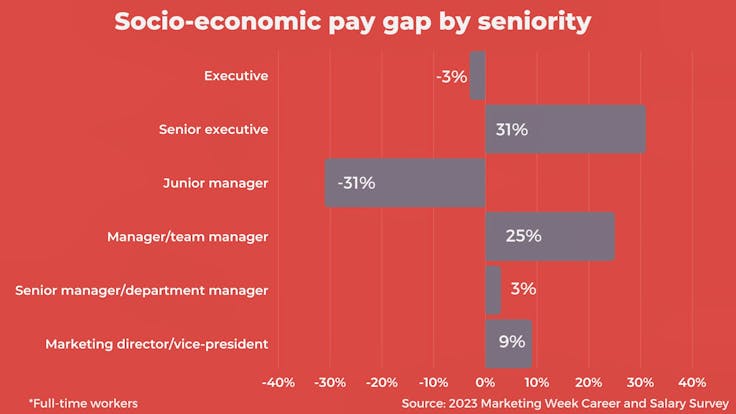Marketing fails to address 18.2% socio-economic pay gap
Work is urgently needed to address the “unwritten codes” hampering the earning potential of talent from diverse socio-economic backgrounds.
 In 2022 the marketing industry was urged to “own” its socio-economic pay gap problem.
In 2022 the marketing industry was urged to “own” its socio-economic pay gap problem.
Speaking to Marketing Week ahead of Class Pay Gap Day (14 November), the point in the year when people from working-class backgrounds in higher professional managerial positions cease earning relative to their peers, Social Mobility Foundation CEO Sarah Atkinson urged the profession to take action.
She identified the “unwritten codes” and strong cultural capital within marketing which act as the “enemy of social mobility”.
Atkinson’s words are reflected in exclusive data from Marketing Week’s 2023 Career and Salary Survey, which reveals a mean socio-economic pay gap for full-time workers of 18.2%. This figure is only slightly down on the 19.1% pay gap reported in 2022.
Among the sample of more than 3,000 respondents, 67.4% identify as middle-class (lower, middle or upper middle), while just 22.1% of marketers describe themselves as coming from a working-class or skilled working-class background.
Despite only making up 6.7% of the sample, marketers who identify as coming from upper-class backgrounds earn on average £69,977 a year. By contrast, marketers from middle-class backgrounds take home an average £65,805 annually, while their peers from working-class backgrounds earn considerably less on average at £56,180.
7 things you can do now to democratise marketing
As was the case last year, the analysis reveals a relationship between socio-economic background and the earning potential of marketers as they climb the career ladder.
Marketers who identify as coming from working-class backgrounds earn more than their middle and upper-class peers in only two roles – executive (3%) and junior manager (31%). Beyond these junior roles, the pendulum swings in the other direction.
Respondents from working-class backgrounds earn 31% less than their middle and upper-class colleagues in the role of senior executive and 25% less as managers/team managers. When it comes to the position of senior manager/department manager, the socio-economic pay gap narrows to 3%, before widening again at marketing director/vice-president level (9%).
While 6.1% of marketers who are identify as coming from working-class backgrounds are in marketing director/vice-president roles, this figure almost doubles for their middle-class peers (11.4%). A further 15.4% of marketers from upper middle/upper-class backgrounds are currently in marketing director/vice-president positions.
Thankfully, the numbers narrow for the role of CMO. Some 4.8% of marketers from upper middle/upper-class backgrounds are chief marketing officers, according to the survey, as are 4.3% of their peers from working-class backgrounds and 3.2% of those who identify as being middle-class.
Rallying call for change
The Career and Salary Survey statistics illustrate a pressing problem for the industry to address. The data backs up the Social Mobility Foundation’s claim that the socio-economic pay gap issue is less well-defined by the marketing industry and therefore “less well-owned”.
On a national level, the foundation is calling on the government to launch a consultation on creating a register for class pay gap reporting, which was the starting point for gender pay gap reporting.
From a marketing specific perspective, Marketing Week launched its Opening Up campaign last year with the aim of democratising marketing careers.
 Shining a light on the ways brands are diversifying their talent pipelines, the campaign has so far highlighted the value of apprenticeships, democratising mentoring and revamping hiring practices. In addition, Marketing Week has promoted the concept of levy share, which enables Apprenticeship Levy paying businesses to donate up to 25% of their unused funds to companies keen to employ apprentices.
Shining a light on the ways brands are diversifying their talent pipelines, the campaign has so far highlighted the value of apprenticeships, democratising mentoring and revamping hiring practices. In addition, Marketing Week has promoted the concept of levy share, which enables Apprenticeship Levy paying businesses to donate up to 25% of their unused funds to companies keen to employ apprentices.
The past year has also seen news of a Marketing T Level, set to kick off in September 2025, which will offer young people the chance to combine study with a “substantial industry placement” of at least nine weeks.
While slow, change is underway. The Guardian kicked off its first six-month paid marketing internship in September, aimed at young talent from diverse socio-economic backgrounds.
In November, drinks giant Diageo teamed up with media agency PHD to give Brixton Finishing School graduates the chance to take part in a one-year programme across the two organisations. Pushing for change for more than five years, the Brixton Finishing School aims to increase graduate-level representation among underrepresented groups in the creative, media and tech industries.
This Much I Learned: How to break the ‘social class taboo’
Elsewhere, the likes of Amazon and BMW have introduced marketing apprenticeships, while insurer Direct Line has donated £325,000 in unspent Apprenticeship Levy to the Co-op’s Levy Share service, helping to fund apprentices for SMEs nationwide.
In December, KPMG published its biggest ‘progression gap’ analysis of the career paths of more than 16,500 of its employees over a five-year period, which found socio-economic background – as measured by parental occupation – had the strongest impact on how quickly an individual progressed through the firm.
The research revealed individuals from lower socio-economic backgrounds took on average 19% longer to progress to the next grade, versus those from higher socio-economic backgrounds.
The professional services firm has committed to increase the number of its leaders from lower socio-economic backgrounds to 29% by 2030. Currently a quarter of KPMG’s partners (25%) come from lower socio-economic backgrounds, up from 23% in 2021.
Speaking to Marketing Week in 2022, KPMG global CMO Sam Burns, discussed being the first person in her family to go to university and how her background gives her a different perspective on the corporate world. She challenged other marketers to think about how they are opening up their recruitment processes and looking at the backgrounds of the talent coming in.
Despite the efforts of some brands, the statistics highlight just how much more needs to be done to level the playing field in terms of attracting talent from diverse socio-economic backgrounds and ensuring they believe marketing is an industry where they can build a lasting career.
*The average salaries for the Career and Salary Survey are calculated from full-time (35+ hours a week) respondents (87.1% of the total sample) providing their basic annual salary, excluding any additional benefits.
Click here to read all the 2023 Career and Salary Survey content so far







